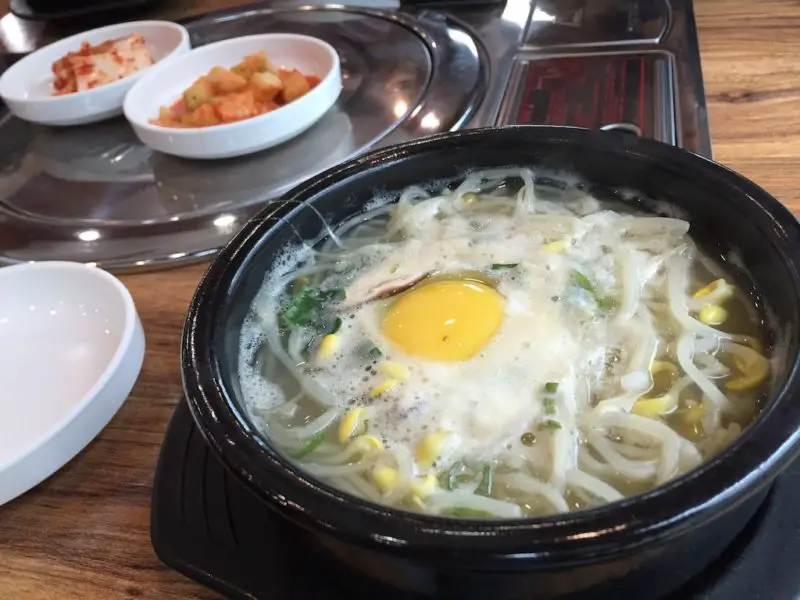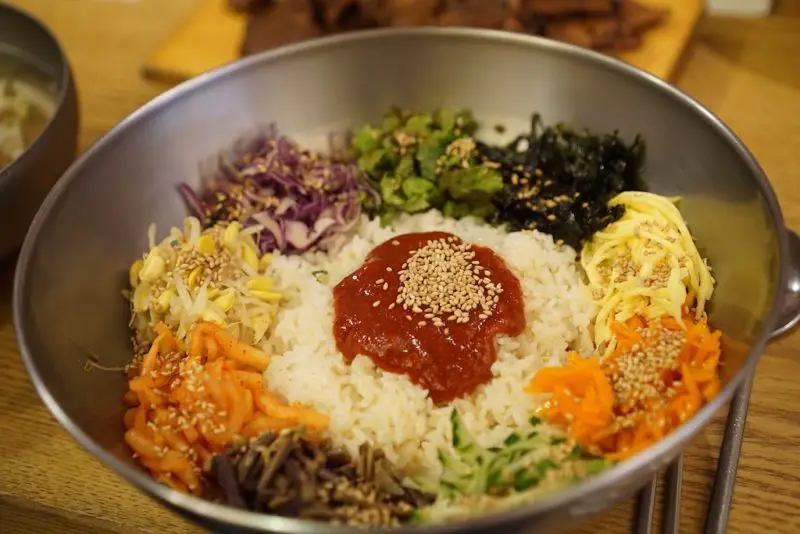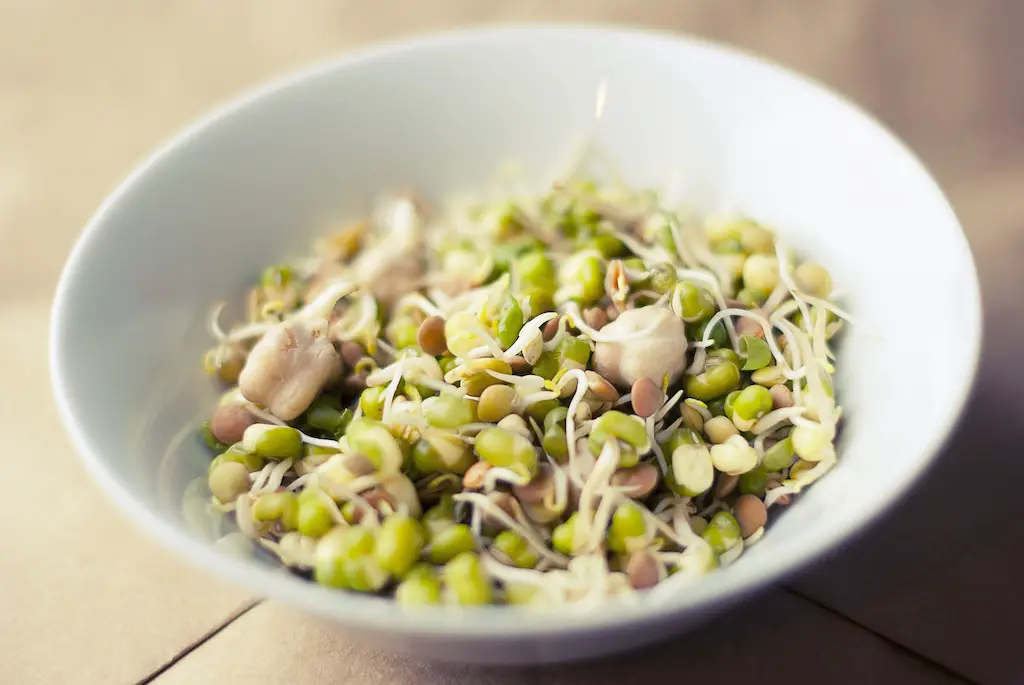This post may contain affiliate links. Please read my disclosure for details at the bottom of this page. As an Amazon Associate, I earn from qualifying purchases on this post about kongnamul, otherwise known as soybean sprouts. We hope you enjoy learning about soybean sprouts in Korean cooking!
Soybeans are a type of legume widely grown and consumed in East Asia. In South Korea, they are used to make culturally significant foods such as tofu, doenjang (fermented soybean paste), soy sauce, and more. But, beyond the beans, people in Korea use the sprouts in a multitude of different ways as well.
Here, we will discuss the use of soybean sprouts in Korean cooking as well as the growing season and where to buy them.
Kongnamul In Korean Culture:
Like I stated above, soybeans are one of the most common ingredients in Korean cuisine–whether people are using their sprouts or beans.
In the Korean language, the term for soybean is ‘mejukong’ (메주콩). People refer to soybean sprouts as ‘kongnamul’ (콩나물). The term ‘kongnamul’ is a compound word made up of ‘kong’ and ‘namul’. The term can refer to both 1) the soybean sprouts themselves, or 2) the ‘namul,’ seasoned vegetable dish or salad, made from soybean sprouts.
The History of Kongnamul in South Korea:
It is thought that soybean sprouts were first introduced to the Korean peninsula during the Three Kingdoms of Korea period. Records of soybean sprouts cultivation and use are found as early as the 13th century in a medical book, Emergency Folk Medicine and Remedies. Published in the kingdom of Goryeo, the book tells of a Taebong general, Bae Hyeon-Gyeong. In 935, he offered soybean sprouts to his starving soldiers.
Note: Taebong was a state established during the later part of the Three Kingdoms of Korea era. Taebong eventually became Goguryeo. Then, all the Kingdoms (Silla, Goguryeo, Gaya, and Baekje) became unified forming Goryeo. Thus, a new era began.
Later on, during the Joseon Dynasty, cooking methods of soybean sprout dishes were included in Farm Management, a farming, cooking, and living book as well as other Joseon documents and texts such as in Literary Miscellany of Seongho and Complete Works of Cheonghanggwan.
Nowadays, soybean sprouts continue to be one of the most popular ingredients used in Korean cooking. They are so common that people serve the namul dish during ‘jesa’ (제사), otherwise known as ancestral rites.

Korean Soybean Sprout Soup
Soybean Sprouts in Korean Cooking:
Like I stated previously in my article about mung bean sprouts, in Korean cooking, soybean sprouts are used way more often than the mung bean alternative found in most western grocery stores. Below, we list some examples of soybean sprout recipes found in Korean cuisine!
- Kongnamul Muchim (콩나물 무침): Kongnamul muchim, otherwise known as soybean sprout salad, is a traditional Korean banchan (side dish). Typically, people in South Korea make this side dish in two different ways. On one hand, some people make a spicy variation using gochugaru (Korean red pepper powder). On the other hand, some people prefer the mild variation made without using gochugaru.
- Kongnamul Guk (콩나물국): In English, people refer to kongnamul guk as soybean sprout soup. Like the salad mentioned above, people make this brothy and light soup either mild or spicy by withholding or adding in red pepper powder.
- Kongnamul Gukbap (콩나물국밥): This dish is a twist on kongnamul guk. In English, ‘guk’ refers to ‘soup’ and ‘bap’ refers to ‘rice.’ This popular style of soybean sprout soup contains rice as well!
- Bibimbap (비빔밥): As I stated in the mung bean sprout article, bibimbap is a popular Korean rice-based dish around the world. To make this dish, you top rice with different types of sauteed and seasoned vegetables. While people use mung bean sprouts, they use soybean sprouts as well!

Bibimbap Containing Soybean Sprouts
Soybean Sprout Season:
Soybean sprouts are available year-round. When choosing fresh sprouts, look for those that do not have any brown spots. Further, these sprouts should have a crispy fresh, when bent they should snap. You do not want them to be soggy.
When cooking with soybean sprouts, I recommend eating them within a few days. Bean sprouts spoil quickly and easily. Throw any away that look like they are turning as bean sprouts easily carry food-borne illnesses.
Where to Buy Soybean Sprouts:
While available year-round, most fresh bean sprouts sold in the United States are of the mung bean variety. To find soybean sprouts, I recommend shopping in your local Asian grocery store.
If you do not live near a store, you can also grow soybean sprouts easily at home! Once again, I recommend checking out Maangchi’s explanation on how to grow them. You can also buy bean sprout machines online!
I Hope You Enjoyed Learning About Soybean Sprouts in Korean Cooking!
In the end, I hope you enjoyed learning about soybean sprouts in Korean cooking (kongnamul). If so, let me know in the comment section below! Further, let me know of recipes you cook at home that use these sprouts!
If you would like to read more about cooking, you can find further recipes on this blog. I listed some of my favorite Carving A Journey recipes below! For reference, many recipes are influenced by my family’s blended Korean and Southern heritage.
Korean Ingredient Articles:
- Mung Bean Sprouts in Korean Cooking
- Green Plums in Korean Cooking (Maesil)
- What are Perilla Leaves (Kkaennip)?
- Dangmyeon (Sweet Potato Glass Noodles)
- Gochugaru (Korean Pepper Powder)
- Korean Soy Sauce: What Should I Buy?
- Gluten-Free Gochujang Brands
- Gluten-free Doenjang Brands
Further Carving A Journey Korean Recipes:
- Mung Bean Sprout Salad (Sukju-Namul Muchim)
- Korean Cabbage Pancakes (Baechu Jeon)
- Jumeokbap (Handmade Korean Rice Balls)
- Bibimmyeon (Korean Spicy Cold Noodles)
If you have any questions or comments, you can also email me at [email protected]. And, finally, I would love to hear from you through our social media as well! You can follow me at @carvingajourney on Instagram, Facebook, and Pinterest. I also started a vlog YouTube channel with my husband! Or, if you would like more articles like these, you can subscribe to the blog by joining the mailing list. I hope you enjoyed learning about the Korean uses of soybean sprouts! Thank you so much for stopping by!
Carving A Journey is a participant in the Amazon Services LLC Associates Program, an affiliate advertising program designed to provide a means for sites to earn advertising fees by advertising and linking to Amazon.com. Although we may earn commissions for our endorsement, recommendation, testimonial, and/or link to any products or services from this website, these opinions are my own and I fully support these products.

